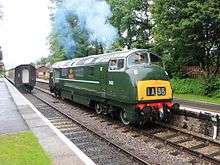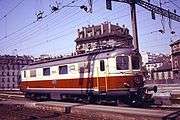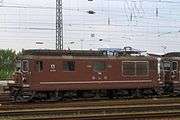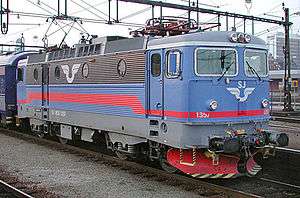Bo-Bo
B-B and Bo-Bo are the AAR and UIC classifications of wheel arrangement for railway locomotives with four axles in two individual bogies. It is a common wheel arrangement for modern electric and diesel locomotives.
Bo-Bo
Bo-Bo is the UIC indication of a wheel arrangement for railway vehicles with four axles in two individual bogies, all driven by their own traction motors. It is a common wheel arrangement for modern electric and diesel-electric locomotives, as well as power cars in electric multiple units.
Most early electric locomotives shared commonalities with the steam engines of their time. These features included side rods and frame mounted driving axles with leading and trailing axles. The long rigid wheelbase and the leading and trailing axles reduced cornering stability and increased weight.
The Bo-Bo configuration allowed for higher cornering speeds due to the smaller rigid wheelbase. Furthermore, it allowed better adhesion because all the wheels were now powered. Due to the absence of frame mounted wheels no leading or trailing axles were necessary to aid cornering, reducing weight and maintenance requirements.
Due to the advent of modern motors and electronics more power can be brought to the rail with only a few axles. Modern electric locomotives can deliver up to 6400 kW on only four axles. For very heavy loads, especially in transportation of bulk goods, a single unit with this wheel arrangement tends to have too little adhesive weight to accelerate the train sufficiently fast without wheelslip.
B′B′

The B′B′ or B-B arrangement is similar, but applies to diesel-hydraulic locomotives rather than diesel-electrics. The axles on each bogie are coupled together mechanically, rather than being driven by individual traction motors. Diesel-hydraulics have their engine mounted on the main frame of the locomotive, together with a hydraulic transmission. Power is then transmitted to the bogies by cardan shafts and a short driveshaft between axles.[1]
A common example of this is the German V200 design and its many international derivatives. The need to arrange the bogie suspension around the drive shafts led to an unusual bogie design with radius arms rather than hornblocks and so prominently visible wheels and rims.[2][3]

In some rare examples, such as the narrow-gauge ÖBB 2095, the bogie axles have been linked by coupling rods. Having only a single final-drive per bogie allows more room for the bogie pivots on this narrow-gauge design. With high power full-size locomotives, splitting the drive directly to two axles is preferred, as it only requires a less powerful final drive gearbox.
In AAR notation a Bo-Bo is regarded as a B-B because the AAR system does not take traction motors into consideration, only powered axles. An AAR-like notation is used in France too, making it hard to tell the B-B and Bo-Bo engines apart, both of which are common there.
| Wikimedia Commons has media related to B'B' locomotives. |
1A-A1

Railcars and multiple units use similar two-axle powered bogies and many of them use similar hydraulic or mechanical transmissions, rather than traction motors. However railcars are also lightweight and do not require all axles to be powered in order to gain adequate adhesion. They thus use a wheel arrangement of 1A-A1 rather than B-B.[4] A common arrangement is for each power car to have two independent engines and transmissions, each driving a single axle of each bogie.
Gallery
|
See also
References
| Wikimedia Commons has media related to Bo'Bo' locomotives. |
- ↑ Bolton, William F. (2006) [1956]. The Railwayman's Diesel Manual (4th ed.). Ian Allan. pp. 132–133. ISBN 0-7110-3197-5.
- ↑ Clough, David N. (2011). "8: A contrast in design". Hydraulic vs Electric: The battle for the BR diesel fleet. Ian Allan. p. 77. ISBN 978-0-7110-3550-8.
- ↑ Lewis, J.K. (2006) [1977]. The Western's Hydraulics. Nottingham: Book Law Publications. p. 50. ISBN 1-901945-54-5.
- ↑ Bolton, pp. 135–136.



